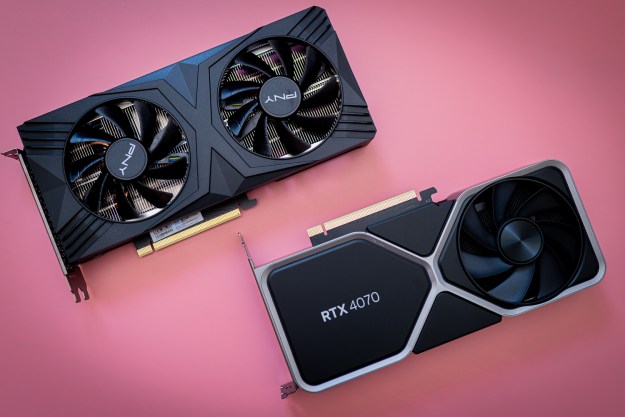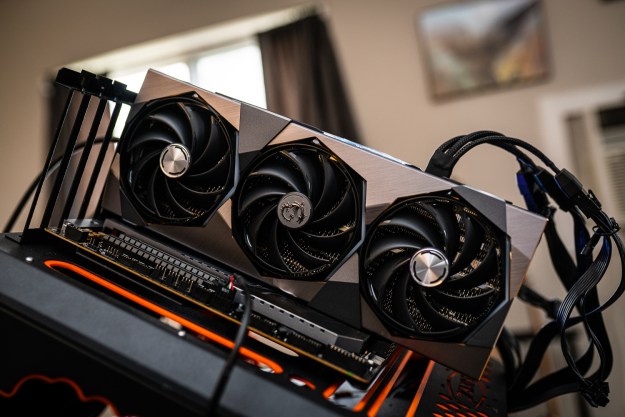
According to the report, Nvidia is ditching its “M” label for notebook-bound GPUs, while sticking with the original names it’s currently using for the desktop graphics chips, namely the GeForce GTX 1080, GTX 1070, and GTX 1060. Given that previously leaked specs show no huge differences between mobile and desktop chips, dropping the “M” label comes as no surprise.
As a recap, here’s what the mobile version of the GTX 1070 supposedly looks like compared to the current desktop version:
| GTX 1070 | Desktop | Mobile |
| GPU | GP104-200 | GP104 |
| CUDA Cores | 1,920 | 2,048 |
| GPU Clocks | 1,506MHz, 1,683MHz | 1,443MHz, 1,645MHz |
| Memory Clocks | 2,002MHz, 8,008MHz | 2,002MHz, 8,008MHz |
| Memory Type | 8GB GDDR5 | 8GDDR5 |
| Memory Bus | 256-bit | 256-bit |
And here are the leaked specs for the GTX 1060 mobile model compared to its desktop counterpart:
| GTX 1060 | Desktop | Mobile |
| GPU | GP106-400 | GP106 |
| CUDA Cores | 1,280 | 1,280 |
| GPU Clocks | 1,506MHz, 1,709MHz | 1,405MHz, 1,671MHz |
| Memory Clocks | 2,002MHz, 8,008MHz | 2,002MHz, 8,008MHz |
| Memory Type | 6GB GDDR5 | 6GB GDDR5 |
| Memory Bus | 192-bit | 192-bit |
So why choose Gamescom to reveal the new mobile GPUs? According to the report, Europe is a big player in the PC gaming sector, with its player population rapidly increasing as of late. Because of this growing hunger for high-performance PC gaming hardware, OEMs have not only expanded their European reach, but are sponsoring eSports events in that region as well.
Typically, Nvidia’s discrete mobile GPUs provide lower performance than their desktop counterparts. That’s because the mobile chips must draw less power since laptops depend on a battery when not plugged into an electrical outlet. That low power dependency limits the clock speeds and keeps the chips cool in a tightly closed environment.
However, what’s interesting here is that Nvidia finally managed to cram desktop performance into a mobile chip. If you compare the desktop and mobile GTX 1060 chips, they’re nearly identical save for the base clock speed. The mobile version of the GTX 1070 supposedly has slightly more CUDA cores than its desktop counterpart, but the clock speeds between the two aren’t too far apart.
Remember, this isn’t the first desktop-class chip Nvidia managed to cram into a notebook. Its first attempt was the discrete Maxwell-based GTX 980 for notebooks released ten months ago, which provides around a 35-percent performance boost over the GTX 980M. That desktop-class chip includes 2,048 CUDA cores, 128 texture units, 64 raster devices, a clock speed of 1,218MHz, and a thermal envelope of around 150 watts.
That all said, with Nvidia launching discrete GPUs for notebooks without the “M” label, Nvidia is expected to lower the prices of its current mobile GPUs, namely the 960M, the 970M, and the 980M, for gaming notebooks. This could actually help the lower-end gaming notebook market while OEMs churn out newer, high-performance and high-dollar solutions within the next month or so based on the GTX 1000 series.
Looking at the calendar, Gamescom really isn’t all that far away, and with recent leaks regarding Nvidia’s new mobile chip lineup really churning the rumor mill within the last month or so, all signs seem to point to the coming gaming convention at Cologne, Germany. As you can see right here, Nvidia will indeed be present at the show.
Editors' Recommendations
- Nvidia RTX 50-series graphics cards: news, release date, price, and more
- Nvidia just fixed a major issue with its GPUs
- AMD might crush Nvidia with its laptop GPUs — but it’s silent on the desktop front
- Nvidia may launch 3 new GPUs, and they’re bad news for AMD
- Intel’s upcoming iGPU might destroy both Nvidia and Apple M2



